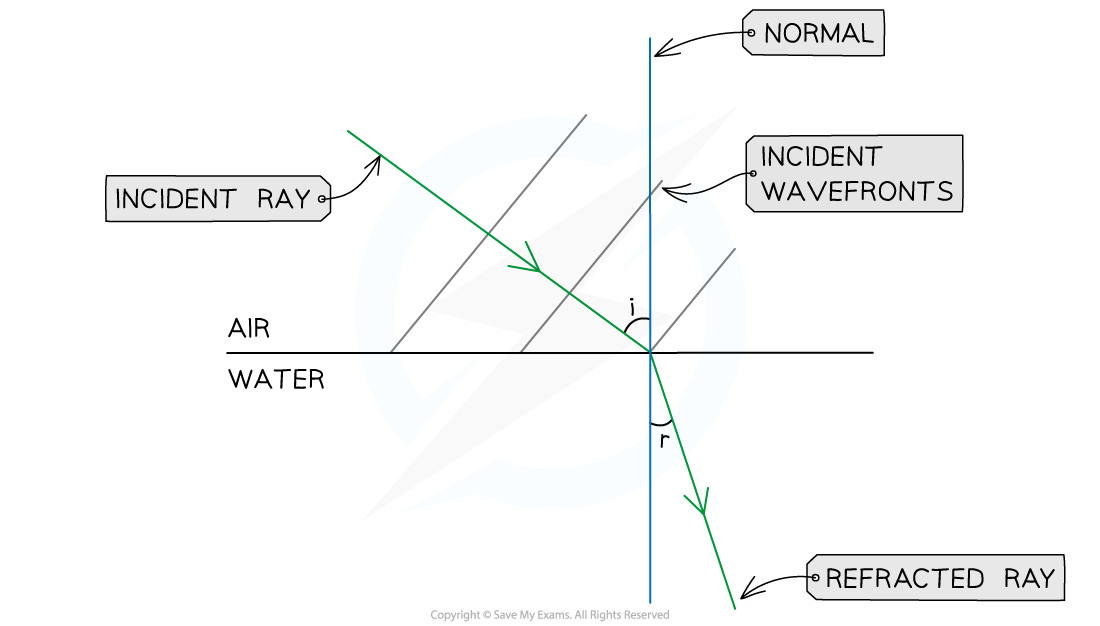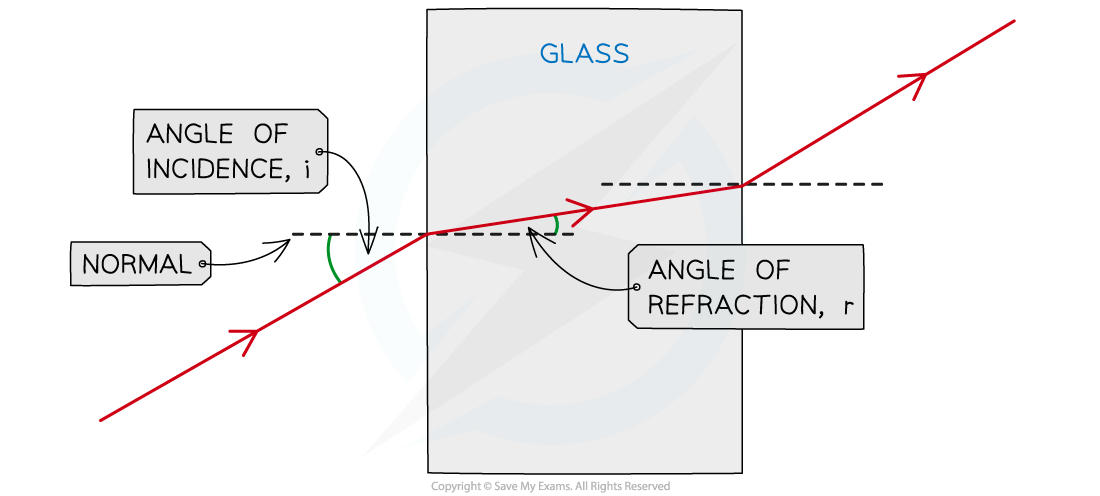Refraction of Light (Cambridge (CIE) IGCSE Physics): Revision Note
Exam code: 0625 & 0972
Did this video help you?
Ray diagrams for refraction
In refraction, angles are measured between the ray (showing the direction of the wave) and the normal line
The angle of the wave approaching the boundary is called the angle of incidence (i)
The angle of the wave leaving the boundary is called the angle of refraction (r)
When drawing a ray diagram an arrow is used to show the direction the wave is travelling
An incident ray has an arrow pointing towards the boundary
A refracted ray has an arrow pointing away from the boundary
The angles of incidence and refraction are usually labelled i and r respectively
Refraction ray diagram

A ray diagram for light refracting at a boundary, showing the normal, angle of incidence and angle of refraction
Refraction of light
Refraction occurs when light passes a boundary between two different transparent materials
At the boundary, the rays of light change direction
This change in direction depends on the difference in optical density between the two media:
From less dense to more dense (e.g air to glass), light bends towards the normal
From more dense to less dense (e.g. glass to air), light bends away from the normal
When passing along the normal (perpendicular) the light does not bend at all
Note that when a light wave enters and leaves the glass block there are two boundaries
The refracted ray at the first boundary becomes the incident ray at the second boundary
Refraction diagram of light from air through a glass block

How to construct a ray diagram showing the refraction of light as it passes through a rectangular block
The change in direction occurs due to the change in speed when travelling in different substances
When light passes into a more optically dense substance, the waves will slow down; hence, they bend towards the normal
When light passes into a less optically dense substance, the waves will speed up; hence, they bend away from the normal
The only properties that change during refraction are speed and wavelength – the frequency of waves does not change
Different frequencies account for different colours of light (red has a low frequency, whilst blue has a high frequency)
When light refracts, it does not change colour (think of a pencil in a glass of water), therefore, the frequency does not change
Examiner Tips and Tricks
Practice drawing refraction diagrams as much as you can! It's very important to remember which way the light bends when it crosses a boundary:
As the light enters the block it bends towards the normal line
Remember: Enters Towards
When it leaves the block it bends away from the normal line
Remember: Leaves Away
You only need to know about light passing through the boundaries between two media.
Investigating Refraction
Aims of the experiment
To investigate the refraction of light using rectangular blocks, semi-circular blocks and triangular prisms
Variables
Independent variable = shape of the block
Dependent variable = angle of refraction
Control variables:
Width of the light beam
Same frequency / wavelength of the light
Equipment list
Equipment | Purpose |
|---|---|
Ray box | To provide a narrow beam of light that can be easily refracted |
Protractor | To measure the angles of incidence and refraction |
Sheet of paper | To mark the lines indicating the incident and refracted rays |
Pencil | To draw the incident and refracted ray lines onto the paper |
Ruler | To draw the incident and refracted ray lines onto the paper |
Perspex blocks (rectangular, semi-circular & prism) | To refract the light beam |
Resolution of measuring equipment:
Protractor = 1°
Ruler = 1 mm
Refraction diagram for equipment

Diagram showing a ray box alongside three different-shaped glass blocks
Method
Refraction diagram set up

Apparatus to investigate refraction
Place the glass block on a sheet of paper, and carefully draw around the rectangular perspex block using a pencil
Switch on the ray box and direct a beam of light at the side face of the block
Mark on the paper:
A point on the ray close to the ray box
The point where the ray enters the block
The point where the ray exits the block
A point on the exit light ray which is a distance of about 5 cm away from the block
Draw a dashed line normal (at right angles) to the outline of the block where the points are
Remove the block and join the points marked with three straight lines
Replace the block within its outline and repeat the above process for a ray striking the block at a different angle
Repeat the procedure for each shape of perspex block (prism and semi-circular)
Analysis of results
Consider the light paths through the different-shaped blocks
Refraction experiment results with different media

Refraction of light through different shapes of perspex blocks
The final diagram for each shape will include multiple light ray paths for the different angles of incidences (i) at which the light strikes the blocks
This will help demonstrate how the angle of refraction (r) changes with the angle of incidence
Label these paths clearly with (1) (2) (3) or A, B, C to make these clearer
Use the laws of refraction to analyse these results
Evaluating the experiment
Systematic errors
An error could occur if the 90° lines are drawn incorrectly
Use a set square to draw perpendicular lines
Random errors
The points for the incoming and reflected beam may be inaccurately marked
Use a sharpened pencil and mark in the middle of the beam
The protractor resolution may make it difficult to read the angles accurately
Use a protractor with a higher resolution
Safety considerations
The ray box light could cause burns if touched
Run burns under cold running water for at least five minute
Looking directly into the light may damage the eyes
Avoid looking directly at the light
Stand behind the ray box during the experiment
Keep all liquids away from the electrical equipment and paper
Examiner Tips and Tricks
In your examination, you might be asked to write a method explaining how you might investigate the refraction of light through different shaped blocks
As part of this method you should describe:
What equipment you need
How you will use the equipment
How you will trace the rays of light before, while and after they pass through the block

Unlock more, it's free!
Did this page help you?